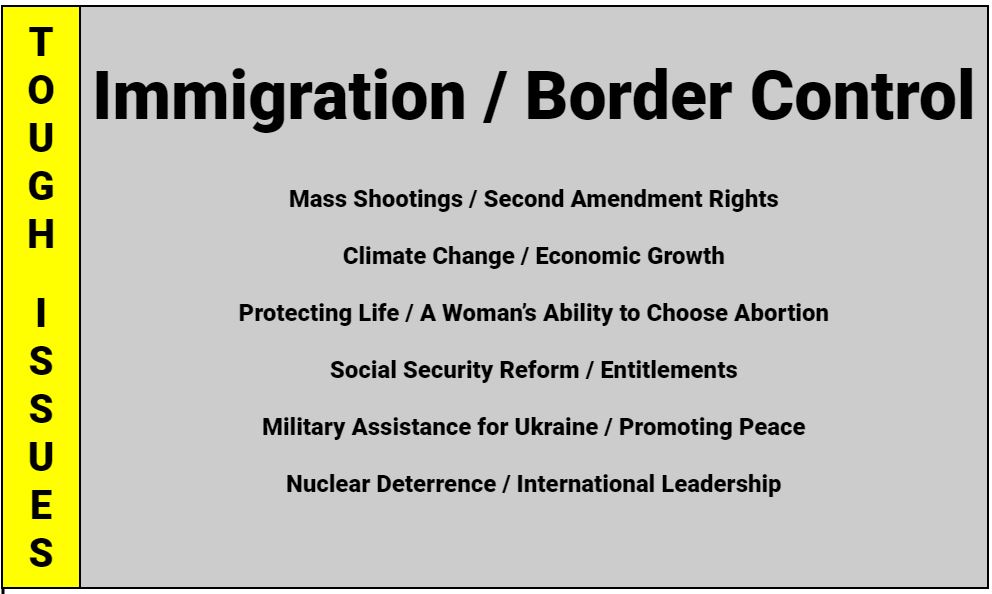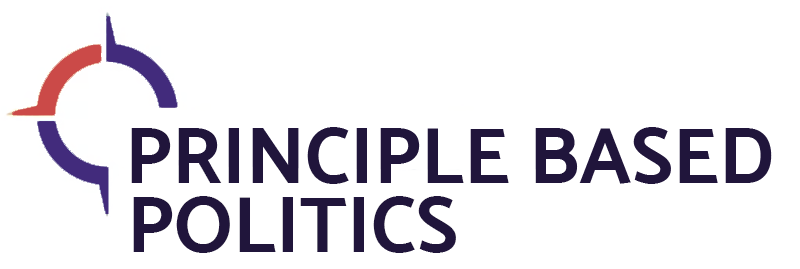
07 Feb Tough Issue #2
Immigration / Border Control
In the very month and year your humble blogger was born, Marty Robbins released his Grammy Award winning hit single, “El Paso.” It begins: “Out in the West Texas town of El Paso, I fell in love with a Mexican girl.” The reason Robbins’ El Paso is in our own head today is that same “West Texas town” is the focal point of much discussion about immigration and border control, which are the two related facets of this week’s “tough issue.”
And the opening lyrics beg the question of how the subject “Mexican girl” would have arrived in the United States today. Would she have presented herself and sought political asylum? Would she have entered lawfully under a work permit or education visa? Would she have snuck or been smuggled in? Would she have attained citizenship by being born in America (as in the song), or would she have been brought here as a child and then become a “Dreamer” wanting to stay under the DACA law?
Immigration certainly is not a simple topic. Nor is border control.
Border and Immigration Basics
What the issue is: How can America allow good people to move here?
Why this issue is difficult: Confusion and human selfishness.
U.S. workers want to keep jobs and see wages increase. U.S. citizens want their communities to be safe. Companies want workers. Foreign people want to improve their lives. Unfortunately, these understandable motives run into another one, which is that U.S. politicians want to win elections. Many of these politicians make the immigration issue difficult by trying to convince the U.S. workers and citizens that jobs will vanish, wages will be suppressed, and safety will be lost if immigration is allowed. Other politicians pander to voters by emphasizing “inhumanity” and “racism” supposedly perpetrated by their political opponents.
Where the issue stands today: People can move to the United States legally through temporary work permits or student visas, or by gaining asylum from danger in their home country. But America has large problems dealing with (1) the millions of people crossing the border to seek asylum and (2) those simply crossing the border illegally. Huge delays plague the processing of asylum claims, and illegal entry is rising.
One specific difficulty is what to do with the asylum seekers while they await a decision on their request to move here. Currently, an anti-Covid rule is being stretched to force would-be immigrants to remain outside the country, and the U.S. Supreme Court will review the legality of that rule shortly.
Another obstacle is that the U.S. immigration policy primarily was designed for an era when mostly Mexican single adults came here looking for work. Now, whole families from all over the world want to enter. Confusion and misinformation outside the United States leads people to believe incorrectly that they will be allowed in here, which increases the numbers of people crossing the border. Throngs are living as refugees in tents and camps, and with others.
Meanwhile, a separate group of around 670,000 people who before 2007 were brought to America illegally as children and now are adults, remain in limbo as Congress has not agreed on whether they should be allowed to stay.
Proposed Resolutions
To resolve confusion-based problems, we need clarity. For selfishness-based difficulties, we must find win-win solutions that are principled.
Principles involved: Freedom and free enterprise, along with protecting the vulnerable, are the American values Principle Based Politics sees as most relevant to immigration and border security, as this blog wrote in Immigration: Applying Principles (July 6, 2021).
Solutions: First, given the shortages of workers necessary to fill labor-intensive jobs in the United States, plus the need by American companies for skilled workers, it would boost the American economy if limits on permitted foreign workers were raised substantially. Only Congress can adjust these numerical caps. It should increase legal immigration to a level equivalent to the job openings posted in America.
The second straightforward action should be for Congress to pass the much discussed “DACA” bill to allow the hundreds of thousands brought here as children, who have attended school or served in the military, and who have no serious criminal record since, to remain and become citizens. These childhood arrivals (the average age of which is now 28) then can pursue higher education and careers. Both Republican and Democratic voters strongly support this pathway to citizenship for the so-called “Dreamers.”
Asylum is the hardest sub-issue to solve. While most asylum seekers probably want in for economic reasons or family unification, rather than purely for personal safety from violence or political repression, the best way to protect those who are truly vulnerable is through speedy screening. That requires budgeting for staff, software, and modern processing systems. With expedited processing, we can justify requiring all border crossers to live in government housing during the very short wait while their applications are adjudicated. Those not in immediate danger of persecution or violence still could be allowed to emigrate with an adequate, objective showing of skills, education, being law-abiding, and able to support themselves without governmental assistance.
Everyone else, including anyone who tries to sneak in after the new policies are in place, must stay out.
Written by Quentin R. Wittrock, founder of Principle Based Politics.
Look for his posts each week, as this blog will explore and promote the idea of principle in politics, both as to individual elected leaders and our federal government as an institution.


Sorry, the comment form is closed at this time.